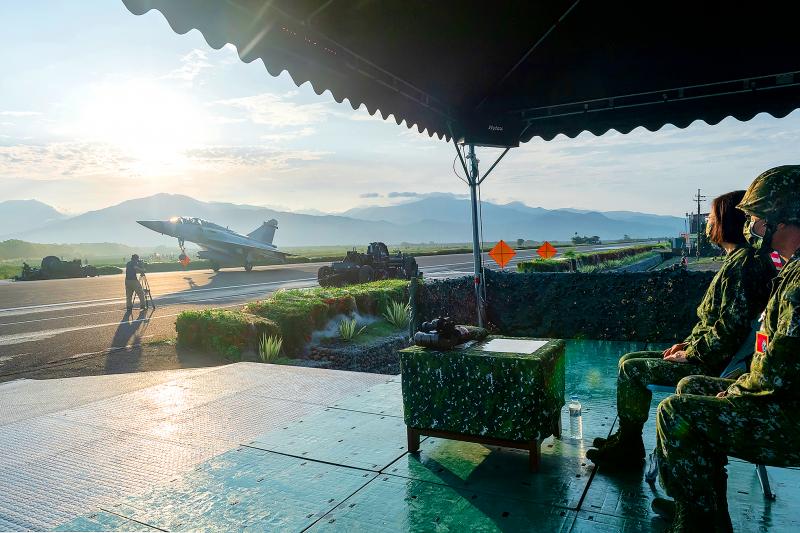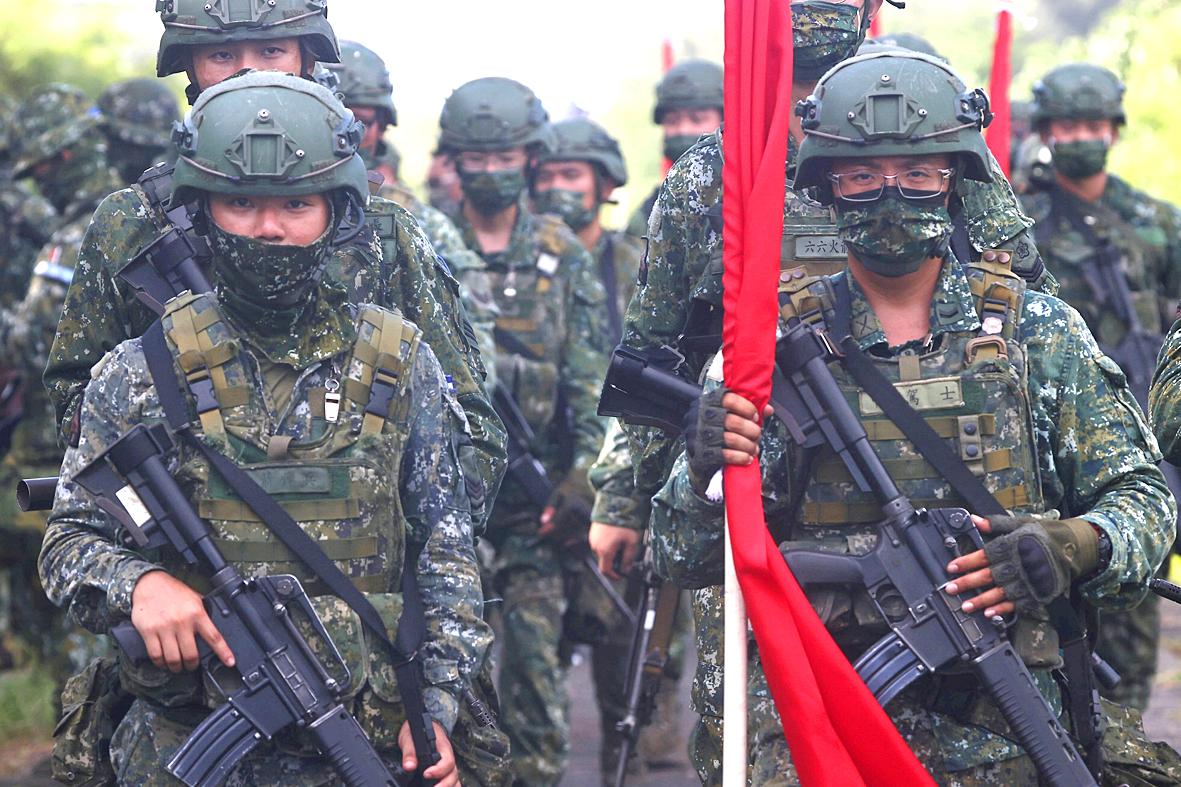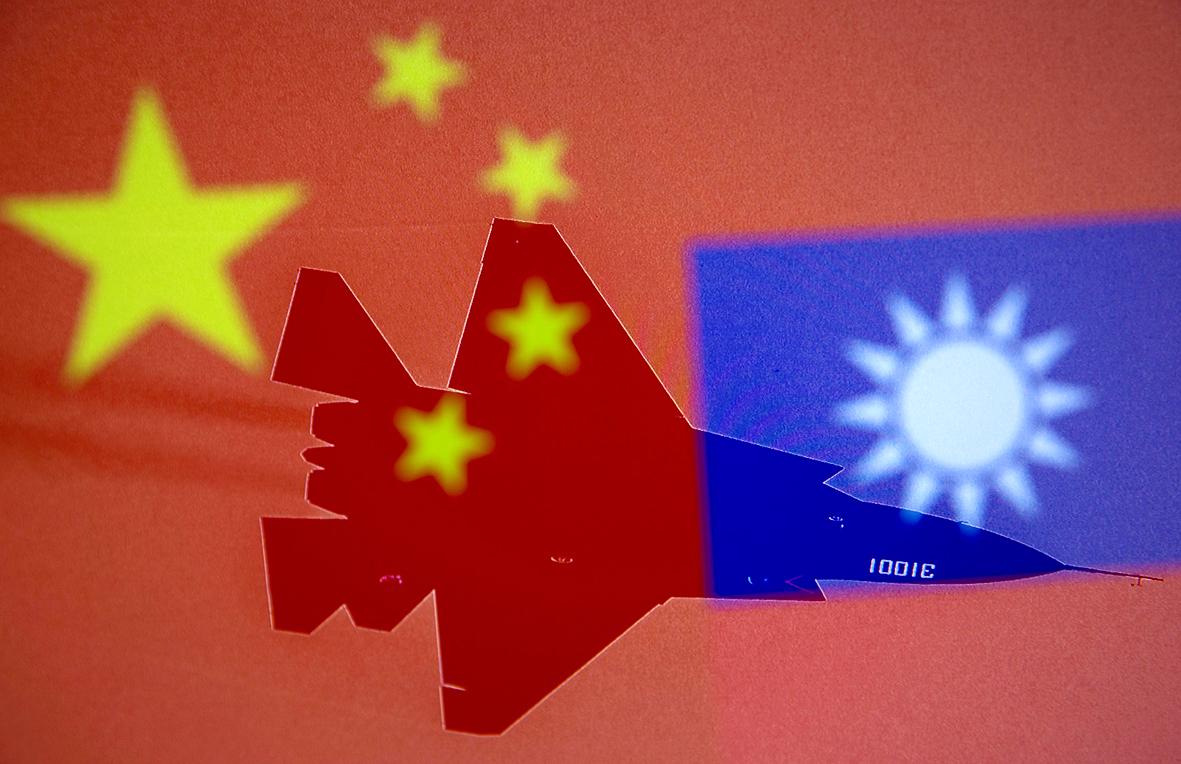Lately, as Beijing increases its threats, voices have begun arguing for Taiwan to increase the duration of conscription, or conscript everyone a la Israel or Switzerland.
These arguments are mere fantasies that there is an easy solution to the China threat, as if it will be scared off if our army is large enough. Indeed, it seems somehow a quintessentially Taiwanese solution: just add labor! Unfortunately, it isn’t what the nation needs.
Fundamentally, if a US-Japan alliance contest the air and sea space around Taiwan, then China cannot invade. At that point the size of the ground force on Taiwan wouldn’t matter. It would be superfluous.

Photo: AP
Conversely, imagine the situation in which China has defeated the combined might of the US and Japan at sea and in the air. It now controls the space around Taiwan and can land troops at will.
Even if every human in Taiwan were conscripted and trained as a soldier, the outcome would not be doubt. Control of the air (and sea) means eventual defeat for defending forces, if the attacker is willing to pay the price.
China would not even have to invade. There’s an old saying: amateurs study tactics, professionals study logistics.

Photo: Reuters
NUMBERS AREN’T THE ANSWER
Our reservists standing ready to fend off a Chinese invasion would have to be fed and clothed and armed. Fed? Taiwan imports something like 65 percent of its calories, but that number is deceptive. For example, on paper we are more than “self-sufficient” in seafood, but of course that involves ships going overseas, which they could not do in the face of Chinese sea control.
People often forget that our animal feed is also mostly imported. When COVID-19 hit last year, Argentina stopped shipping forage corn to Taiwan, which caused a food crisis among local pig farmers. Imagine if feed imports stopped completely under a Chinese blockade.

Photo: Reuters
Nor can Taiwan simply ramp up food production. According to a report on Taiwan’s food security from the Food and Fertilizer Technology Center for the Asian and Pacific Region, Taiwan’s Ministry of the Interior has targeted 800,000 acres for farm production, but only 520,000 are actually in production.
The report notes that massive investment in technology firms has left agriculture bereft of investment in capital and advanced technology. The labor force is small, and the farmers old. Poor storage and shipping management means that 40 percent of fruit and vegetable production is wasted. These problems cannot be changed overnight.
The food issue cannot be emphasized enough. Even if there is no blockade, in the event of war international shippers are going to demand astronomical rates for moving things to Taiwan, to pay their skyrocketing insurance costs.
Neither the US nor Japan possesses the sealift to simultaneously carry out operations in the Pacific and supply 23 million people in Taiwan with food. Food prices in Taiwan will spike, and the poorest will die, a scenario repeated in countless wars throughout history.
In other words, the best employment for the fantasy army of Taiwanese reservists would be as agricultural laborers. If the Chinese settle down to blockade and siege, then that is likely where most conscripts will wind up.
Further, Taiwan imports almost all of its oil and basic raw materials for chemical and metal production. It also imports much of its advanced machinery, and of course, large quantities of industrial labor. All of that would grind to a halt under a blockade.
Food aside, a large reserve call-up would face insuperable problems of finding housing and weapons for the soldiers, all of which would have to be stored against that terrible day. It would mean the maintenance of a large corps of officers to permanently staff skeleton divisions ready to be expanded at any moment. It would mean inexperienced officers carrying out the call-up for real for the first time ever as invasion looms.
It would also mean the militarization of society. I think we all know what that would do to Taiwan’s democracy.
CRITICAL INFRASTRUCTURE
But let’s imagine that this massive reservist force can somehow be sustained and deployed against an invading Chinese army. With control of the air, the attackers are bombing anything that moves on land, killing the island’s electricity production, wrecking (or threatening to) nuclear plants, bombing water systems, irrigation infrastructure and rail lines. Fighting is constant, in densely populated urban areas, where scraggly militias contend with well-armed professional soldiers.
Prolonged armed resistance would simply mean what we are now seeing in Afghanistan and a thousand other places throughout history: widespread starvation, the reappearance of deficiency diseases, the wrecking of need infrastructure and mass death, especially of non-combatants. What a massive reserve force really means is pyres of dead, to no good end.
Nor would our fantasy reservists stop the population transfers. Stalin forcibly moved whole ethnic populations while at war with Germany. So will Chinese President Xi Jinping (習近平). Those car ferries constructed to transport tanks and soldiers to Taiwan will not return empty. They will be filled with Taiwanese hostages.
If the Chinese achieve control of the air and sea around Taiwan, and it appears that the US and its allies will be unable to wrest it back, at that point the best option is probably not further resistance. Again, our reservists will be superfluous.
Places like Finland and Israel face significant threats from land. That is why they have a large force of trained reservists who can be called up in the event of invasion. The threat to Taiwan is an invasion across water. For that the best answer is a small, highly-trained and mobile professional force that can squash an invasion before it establishes a beachhead.
Instead of spending money on fantasy armies, Taiwan should be (and is) focusing on asymmetric warfare, on pumping up production of missiles, mines, drones, fast attack boats and on basics like constant training. It needs to be ramping up cooperation with the US and Japan and with eastern European countries. Like Taiwan, they face a giant, rapacious neighbor. They get it.
Maybe one glorious day they will be able to change western European minds, and we will be able to expand our sources of weapons and training, and grow our allies.
That would be a lot more useful than a massive reserve force.
Notes from Central Taiwan is a column written by long-term resident Michael Turton, who provides incisive commentary informed by three decades of living in and writing about his adoptive country. The views expressed here are his own.

The Taipei Times last week reported that the rising share of seniors in the population is reshaping the nation’s housing markets. According to data from the Ministry of the Interior, about 850,000 residences were occupied by elderly people in the first quarter, including 655,000 that housed only one resident. H&B Realty chief researcher Jessica Hsu (徐佳馨), quoted in the article, said that there is rising demand for elderly-friendly housing, including units with elevators, barrier-free layouts and proximity to healthcare services. Hsu and others cited in the article highlighted the changing family residential dynamics, as children no longer live with parents,

It is jarring how differently Taiwan’s politics is portrayed in the international press compared to the local Chinese-language press. Viewed from abroad, Taiwan is seen as a geopolitical hotspot, or “The Most Dangerous Place on Earth,” as the Economist once blazoned across their cover. Meanwhile, tasked with facing down those existential threats, Taiwan’s leaders are dying their hair pink. These include former president Tsai Ing-wen (蔡英文), Vice President Hsiao Bi-khim (蕭美琴) and Kaohsiung Mayor Chen Chi-mai (陳其邁), among others. They are demonstrating what big fans they are of South Korean K-pop sensations Blackpink ahead of their concerts this weekend in Kaohsiung.

Taiwan is one of the world’s greatest per-capita consumers of seafood. Whereas the average human is thought to eat around 20kg of seafood per year, each Taiwanese gets through 27kg to 35kg of ocean delicacies annually, depending on which source you find most credible. Given the ubiquity of dishes like oyster omelet (蚵仔煎) and milkfish soup (虱目魚湯), the higher estimate may well be correct. By global standards, let alone local consumption patterns, I’m not much of a seafood fan. It’s not just a matter of taste, although that’s part of it. What I’ve read about the environmental impact of the

Oct 20 to Oct 26 After a day of fighting, the Japanese Army’s Second Division was resting when a curious delegation of two Scotsmen and 19 Taiwanese approached their camp. It was Oct. 20, 1895, and the troops had reached Taiye Village (太爺庄) in today’s Hunei District (湖內), Kaohsiung, just 10km away from their final target of Tainan. Led by Presbyterian missionaries Thomas Barclay and Duncan Ferguson, the group informed the Japanese that resistance leader Liu Yung-fu (劉永福) had fled to China the previous night, leaving his Black Flag Army fighters behind and the city in chaos. On behalf of the